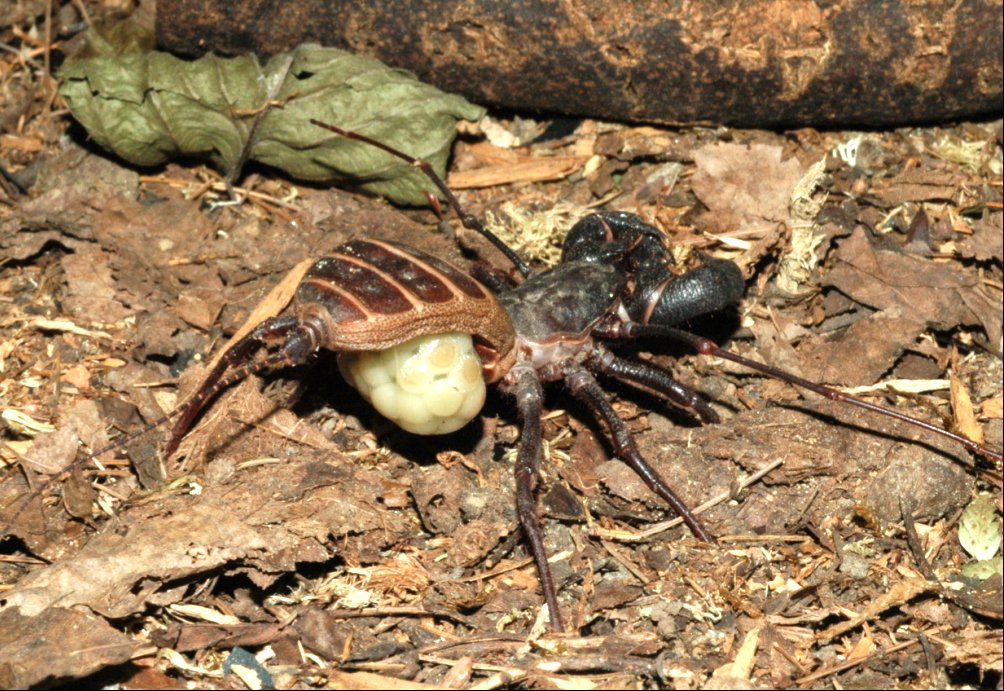Form and Function
 Mastigoproctus giganteus
are typically 3.5 cm to 7.5 cm long when fully grown. (Drees and
Jackson 1999, Hembree 2013). Like all Arthropods, they possess a
hardened cuticle, segmented bodies, jointed limbs, and have the
feature of molting (Budd and Telford 2009). See
Classification for more
phylogenetic details of M. giganteus.
Mastigoproctus giganteus
are typically 3.5 cm to 7.5 cm long when fully grown. (Drees and
Jackson 1999, Hembree 2013). Like all Arthropods, they possess a
hardened cuticle, segmented bodies, jointed limbs, and have the
feature of molting (Budd and Telford 2009). See
Classification for more
phylogenetic details of M. giganteus.
M. giganteus has a set of large pincers as their
mouthparts called pedipalps, which they use to crush their
prey and dig burrows in the surrounding soil. Their rear three
sets of legs are used for walking and the foremost pair are thin
appendages used as sensory structures for feeling the
Vinegaroon’s surroundings (Drees and Jackson 1999, Punzo 2007).
Female Vinegaroons are generally larger than males (Punzo 2007),
but males have much larger pedipalps (Weygoldt 1970). M.
giganteus reproduces through sexual reproduction and the
females carry their eggs in a clear sac attached to the
female’s
 gonophore. After the larvae develops, the
young whipscorpions will climb
onto the abdomen of their mother and stay there until they have
developed enough to live independently (Schmidt 2009). See
Life History and Reproduction for more details on
this process.
gonophore. After the larvae develops, the
young whipscorpions will climb
onto the abdomen of their mother and stay there until they have
developed enough to live independently (Schmidt 2009). See
Life History and Reproduction for more details on
this process.
M. giganteus secretes a chemical spray that has been
shown by several scientific studies to be 83-84% acetic acid,
11% water, and 5% octanoic acid with only trace elements of
other chemicals (Eisner et al. 1961, Schmidt et al. 1999). You
are most likely familiar with acetic acid, as it is the primary
component of vinegar—thus the common name Vinegaroon. While
acetic acid is harmless to be ingested or in the mouth in small
concentrations, at 84% it can irritate and burn,
and more importantly, it can be severely damaging to the sensory
or respiratory systems of other organisms. At these points, the
chemical compound can directly contact nerve endings and has
very little chance of being diluted. The chemical spray is used
for protection, and is not thought to be used as a predation
strategy by the Vinegaroon (Eisner et al. 1961, Schmidt et al.
1999). To learn more about M. giganteus’s predation
habits, visit the Interactions
page.
The chemical spray of the Vinegaroon is secreted by the pygidial
gland, which consists of two thinly walled sacs that sit in the
abdomen of the organism, and are connected by ducts to two
controlled slits in a knob at the base of its tail
(Eisner et al. 1961, Schmidt et al 1999). The spray is released
when M. giganteus comes in direct contact with a
predator. The acidic chemical concoction is discharged from the
opening of the slits at the base of its signature whip-like
flagellum, which extends from its rear (Eisner et al. 1961, Kern
and Mitchell 2011). The spray is released as a mist of fine
droplets, and is usually aimed on the portion of the M.
giganteus’s body that is being attacked (Eisner et al.
1961, Schmidt et al. 1999). This way the spray is most likely to
come in contact with the head, and most importantly the sensory
systems, of the attacker, where it will be most effective. The
spray is aimed by the large knob at the base of the flagellum
and has a maximum range of around 80 cm (Eisner et al. 1961). To
see a video of M. giganteus releasing its spray, click
HERE. Since the spray is released from the base of the tail,
the purpose of the long tail has often been brought into
question. However, it has since been determined that because the
rear of M. giganteus is the weak point in its hardened
armor, the whipping tail can serve as protection by preventing
predators from accessing the posterior of the Vinegaroon
(Schmidt 2009).
It has been suggested
that chemical defenses in arthropods arose as a defense
mechanism specifically because of the selective pressure of
vertebrate predators, who are much quicker and more
agile, making arthropods that are not equipped with defenses an
easy target for these vertebrates (Evans and Schmidt 1990). This
is most likely the reason the chemical secreting, pygidial gland
arose in M.
giganteus.
Continue to Life History and Reproduction
Return to Home
See References